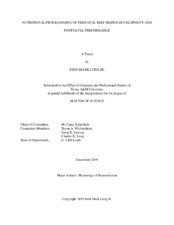| dc.description.abstract | Maternal nutrient restriction during pregnancy has been shown to impact postnatal life in beef cattle; examples include impaired immune, metabolic, and reproductive function, and reduced growth rate and carcass characteristics. Despite potential economic ramifications, epigenetic modifications to aforementioned physiological systems have yet to be elucidated in prenatal beef heifer development. To investigate cellular and molecular alterations associated with postnatal phenotype, we capitalized on embryo splitting technologies to develop a monozygotic twin model of maternal nutritional restriction. Each demi-embryo was individually transferred into phenotypically uniform virgin dams of similar breed type. Beginning on gestational day (GD) 158, dams carrying one identical twin were reduced to 70% NRC while dams carrying the other identical twin were assigned100% NRC. Dams carrying a twin whose identical counterpart was lost were labeled half-siblings, and randomly assigned to either control or 70% NRC. Identical twin pregnancies were necropsied on GD 265 while half-siblings were maintained through parturition. Initially, there was no difference in dam BW, REA, or LRBF. Dams on a restricted diet gained less BW and had smaller REA at the end of treatment, while LRBF did not differ. Restricted twin fetuses exhibited lighter pancreases with lower insulin concentrations in fetal umbilical vein.
At birth, half-sibling calves from restricted pregnancies were lighter than control. Restricted calves were lighter than control at postnatal day (PND) 35 and 70. There was no difference in calf BW from PND 105 through PND 485. At weaning (PND210), there was no difference in REA or LRBF. There were also no differences in REA or LRBF at PNDs 315, 420, or 485, or time of puberty. At slaughter, heifers from restricted dams had greater internal fat and lighter pituitary glands, with impaired glucose clearance. Collectively, results indicate that modest maternal nutrient restriction during late pregnancy alters pancreatic development, and these alterations contribute to compensatory growth in early postnatal life. Furthermore, nutrient restriction suggests increased visceral fat deposition and impaired blood glucose clearance. The observed alteration in development of the pituitary is of interest and future studies are needed to determine cellular and hormonal alterations and associated ramifications to performance. | en |


